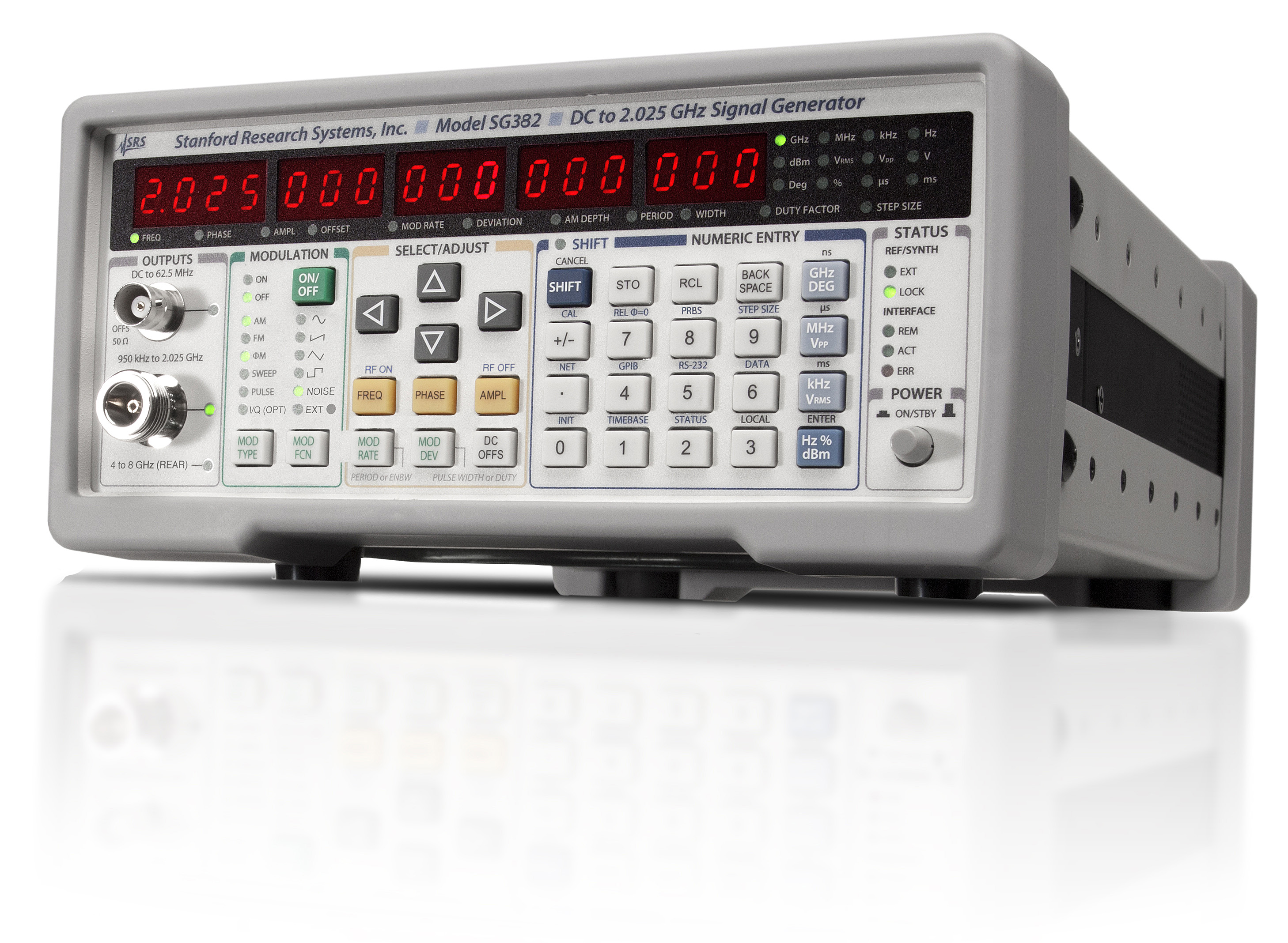
SG380 Series RF Signal Generator



| The SG380 Series RF Signal Generators use a unique, innovative architecture (Rational Approximation Frequency Synthesis) to deliver ultra-high frequency resolution (1 µHz), excellent phase noise, and versatile modulation capabilities (AM, FM, ØM, pulse modulation and sweeps) at a fraction of the cost of competing designs. The standard models produce sine waves from DC to 2.025 GHz (SG382), 4.05 GHz (SG384) and 6.075 GHz (SG386). |
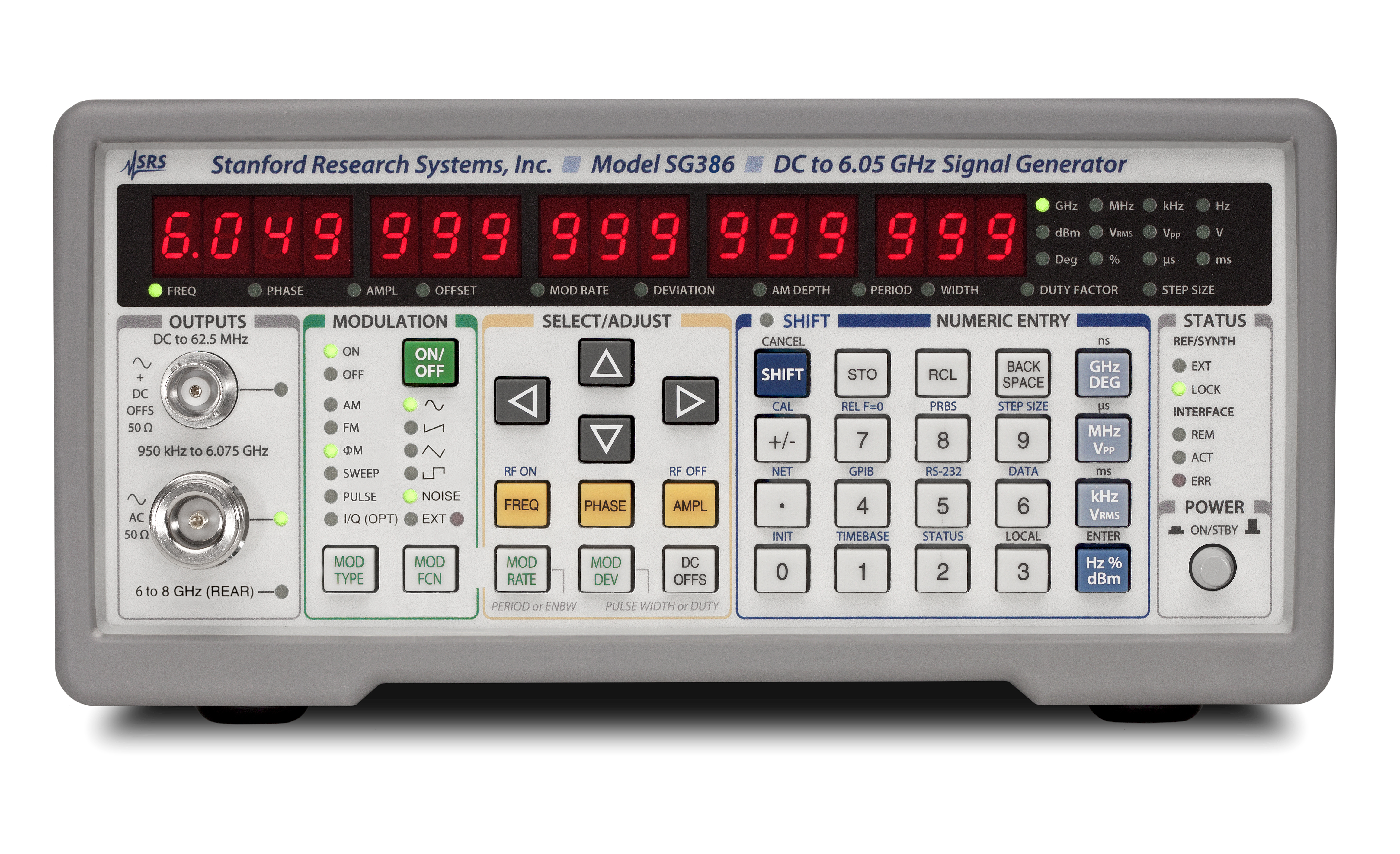
SG380 Series RF Signal Generator

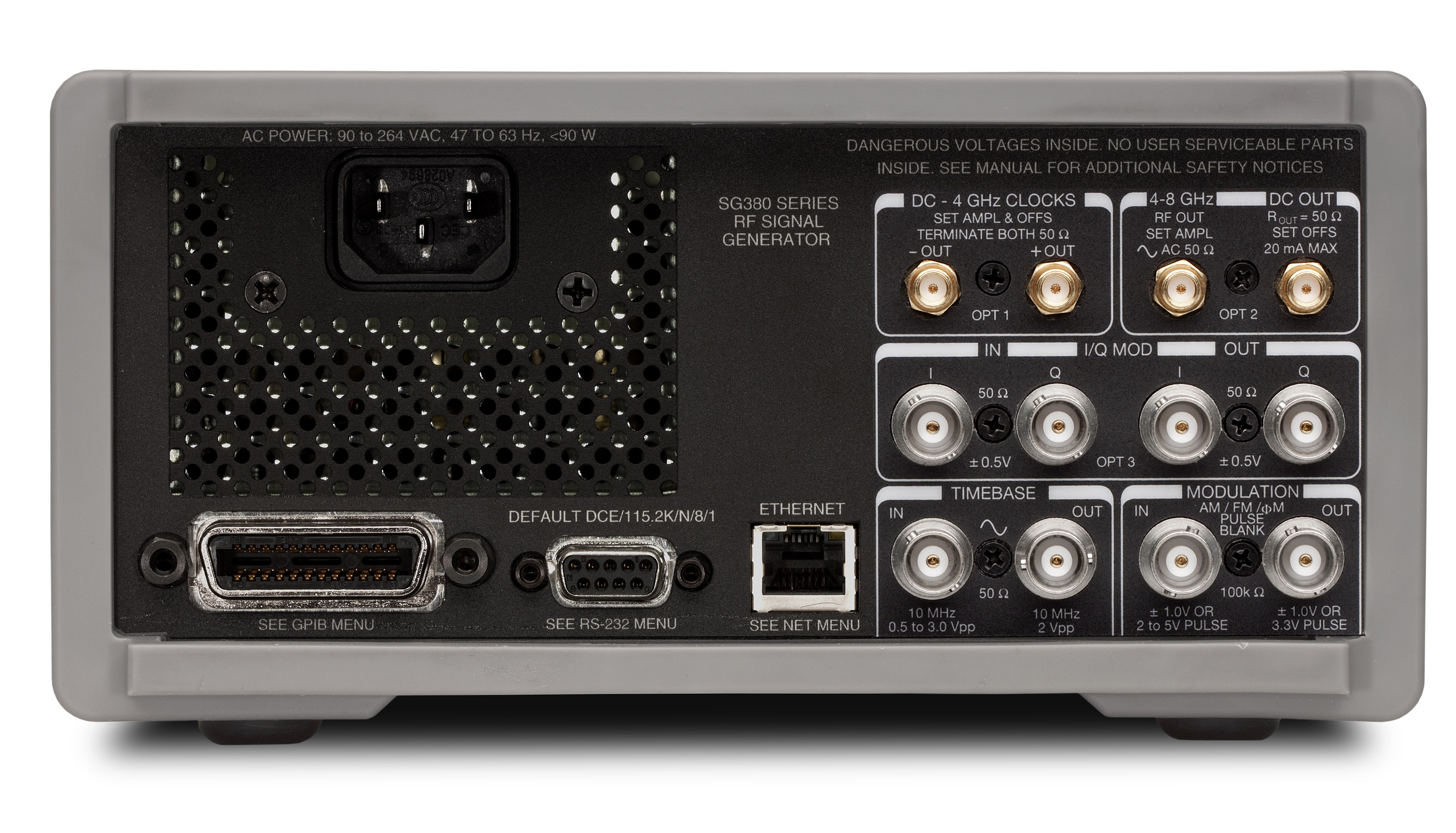
SG380 Series RF Signal Generator

SG380 Series RF Signal Generators
SG380 Series
Introducing the new SG380 Series RF Signal
The SG380 Series RF Signal Generators use a unique, innovative architecture (Rational Approximation Frequency Synthesis) to deliver ultra-high frequency resolution (1 µHz), excellent phase noise, and versatile modulation capabilities (AM, FM, ØM, pulse modulation and sweeps) at a fraction of the cost of competing designs.
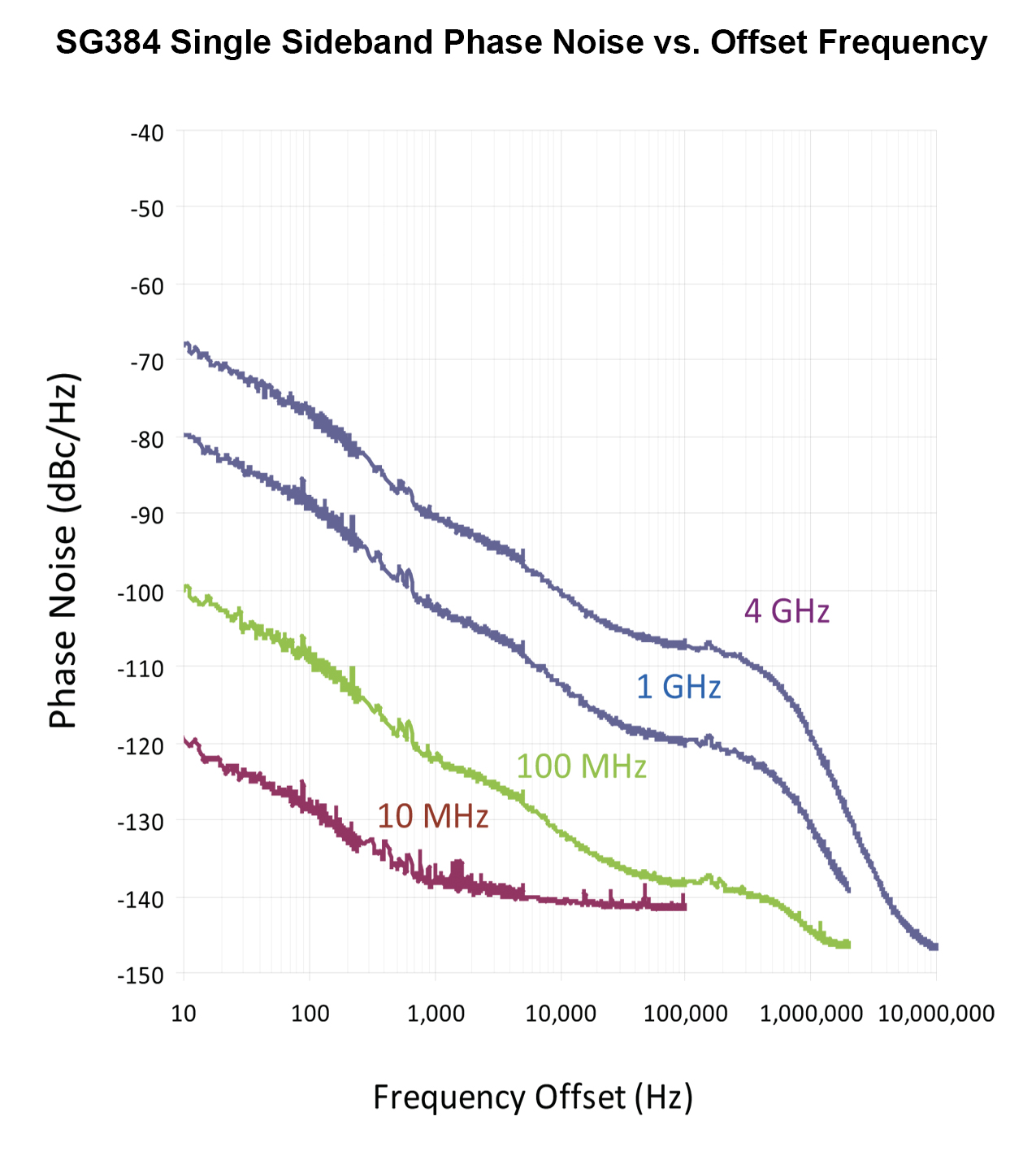
Phase Noise 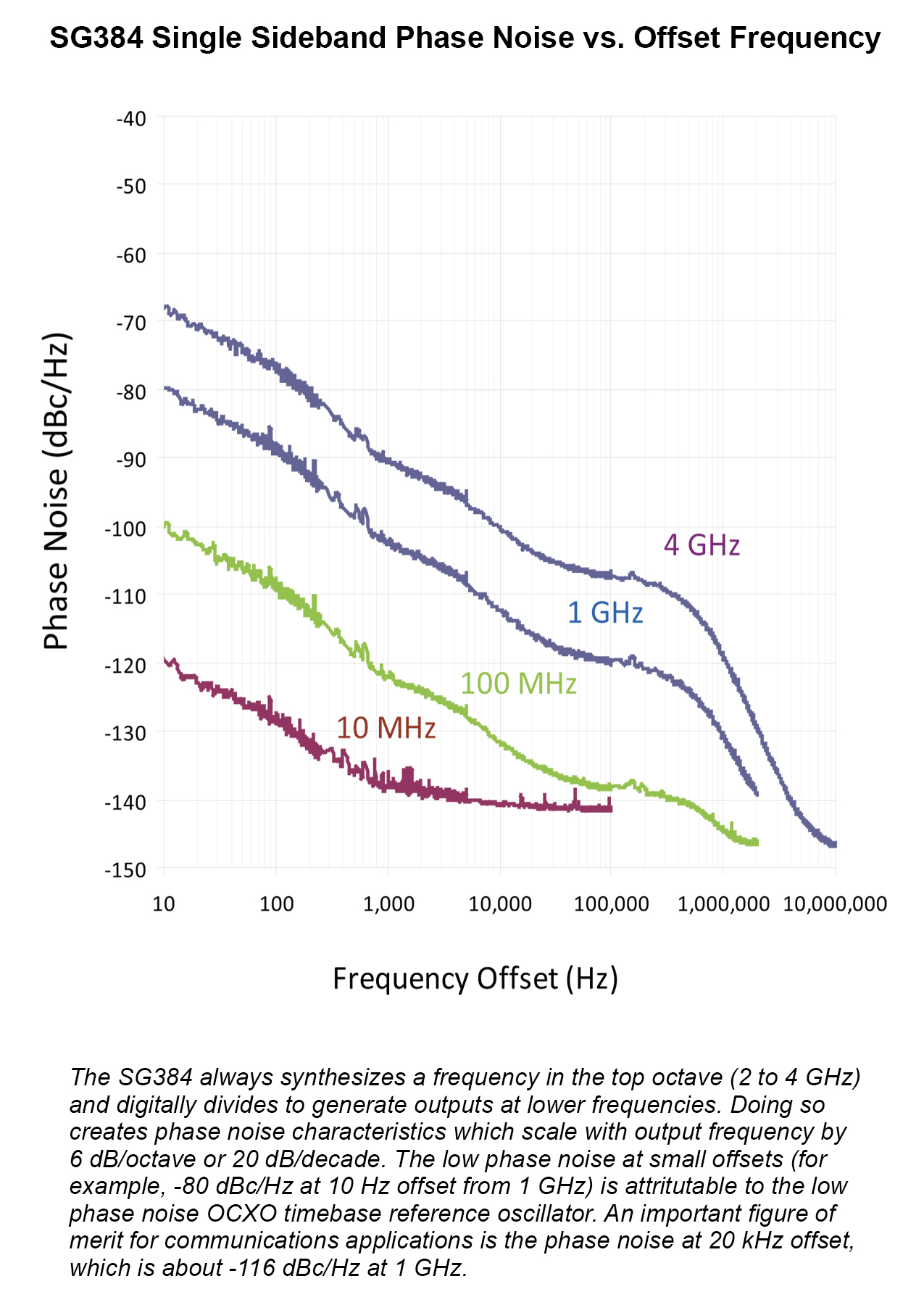
|
The standard models produce sine waves from DC to 2.025 GHz (SG382), 4.05 GHz (SG384) and 6.075 GHz (SG386). There is an optional frequency doubler (Opt. 02) that extends the frequency range of the SG384 and SG386 to 8.10 GHz.
On the Front Panel
The SG380 Series Signal Generators have two front-panel outputs with overlapping frequency ranges. A BNC provides outputs from DC to 62.5 MHz with adjustable offsets and amplitudes from 1 mV to 1 Vrms into a 50 Ω load. An N-type output sources frequencies from 950 kHz to 4.05 GHz with power from +16.5 dBm to -110 dBm (amplitude from 1 Vrms to 0.707 µVrms) into a 50 Ω load.
Modulation
The SG380 Signal Generators offer a wide variety of modulation capabilities. Modes include amplitude modulation (AM), frequency modulation (FM), phase modulation (ΦM), and pulse modulation. There is an internal modulation source as well as an external modulation input. The internal modulation source produces sine, ramp, saw, square, and noise waveforms. An external modulation signal may be applied to the rear-panel modulation input. The internal modulation generator is available as an output on the rear panel.
Unlike traditional analog signal generators, the SG380 Series can sweep continuously from DC to 62.5 MHz. And for frequencies above 62.5 MHz, each sweep range covers more than an octave.
OCXO or Rubidium Timebase
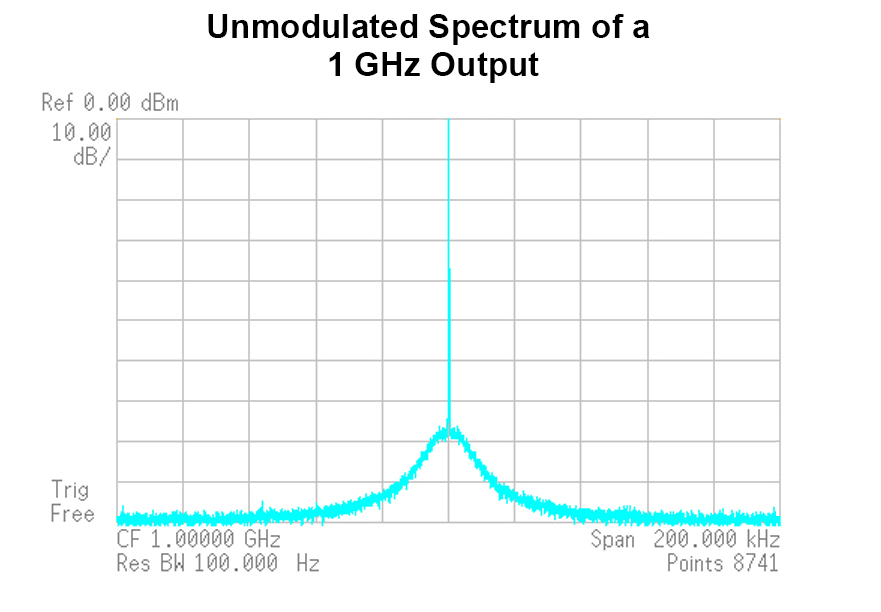
1 GHz Spectra 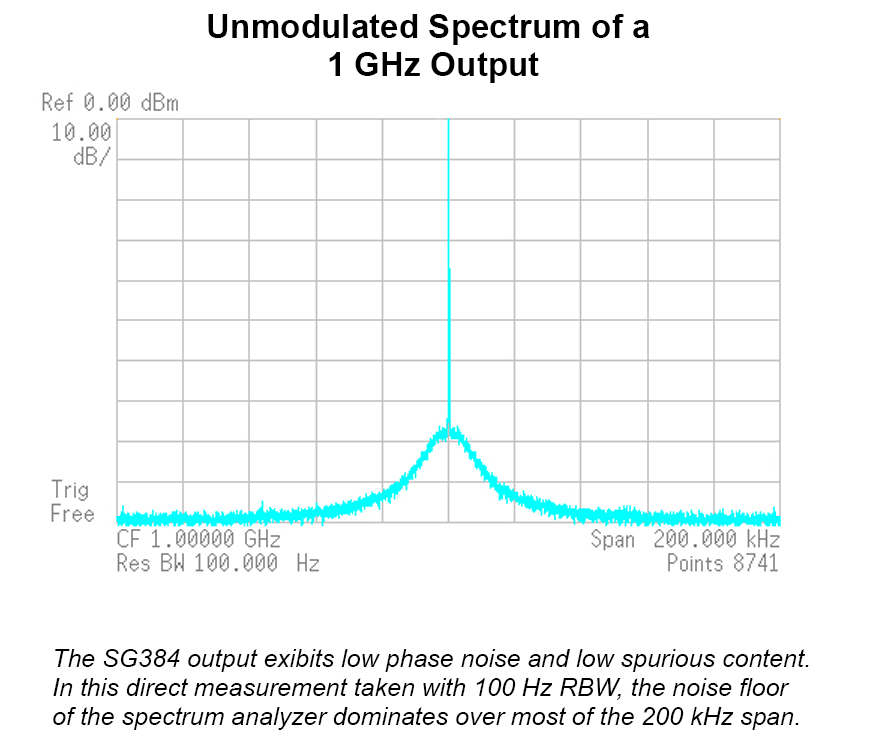
|
The SG380 Series come with a oven-controlled crystal oscillator (OCXO) timebase. The timebase uses a third-overtone stress-compensated 10 MHz resonator in a thermostatically controlled oven. The timebase provides very low phase noise and very low aging. An optional rubidium oscillator (Opt. 04) may be ordered to substantially reduce frequency aging and improve temperature stability.
The internal 10 MHz timebase (either the standard OCXO or the optional rubidium reference) is available on a
Square Wave Clock Outputs
Optional differential clock outputs (Opt. 01) are available on the rear-panel that make the SG380 Series precision clock generators in addition to signal generators. Transition times are typically 35 ps, and both the offset and amplitudes of the clock outputs can be adjusted for compliance with PECL, ECL, RSECL, LVDS, CML, and NIM levels.
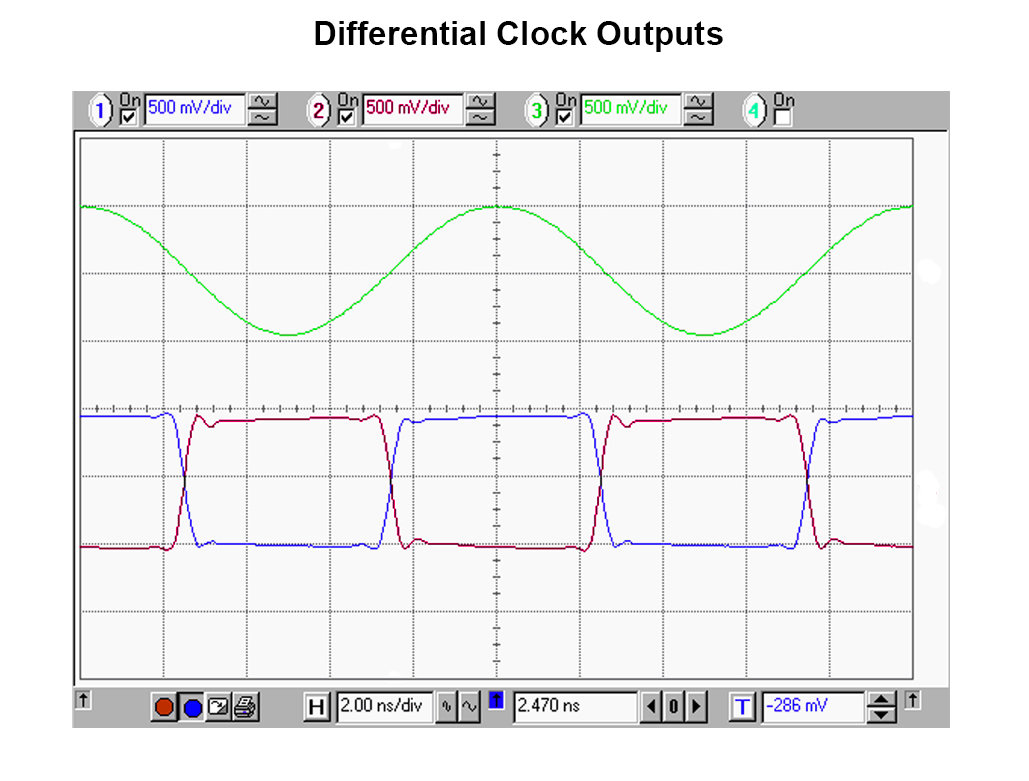
Clock Outputs 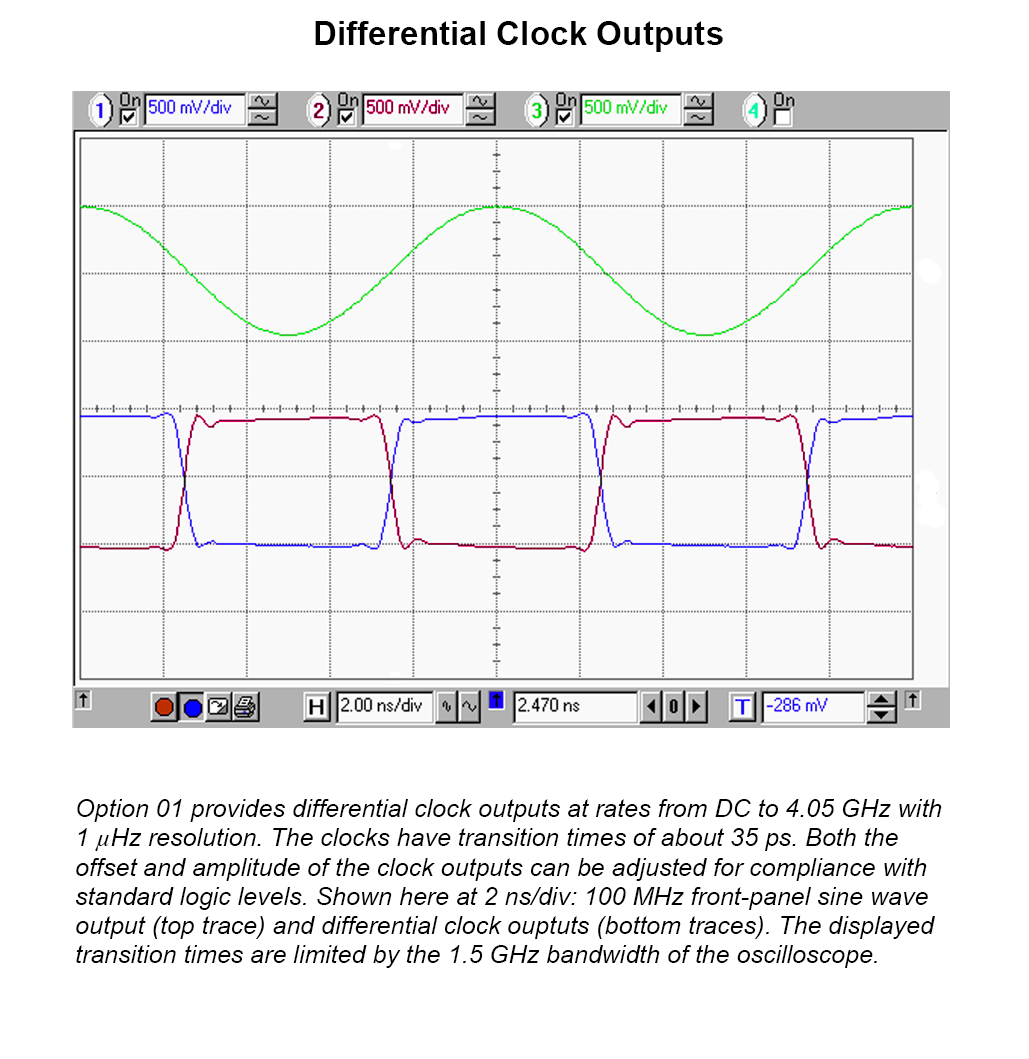
|
I/Q Inputs
Optional I/Q inputs (Opt. 03) allow I & Q baseband signals to modulate carriers from 400 MHz to 6.075 GHz. This option also allows the I/Q modulator to be driven by an internal noise generator with adjustable amplitude and bandwidth.
Output Frequency Doubler
The SG384 and SG386 can be ordered with a frequency doubler (Opt. 02) that extends the frequency range to 8.10 GHz. The amplitude of the rear-panel RF output can be adjusted from
Easy Communication
Remote operation is supported with GPIB,
A New Frequency Synthesis Technique
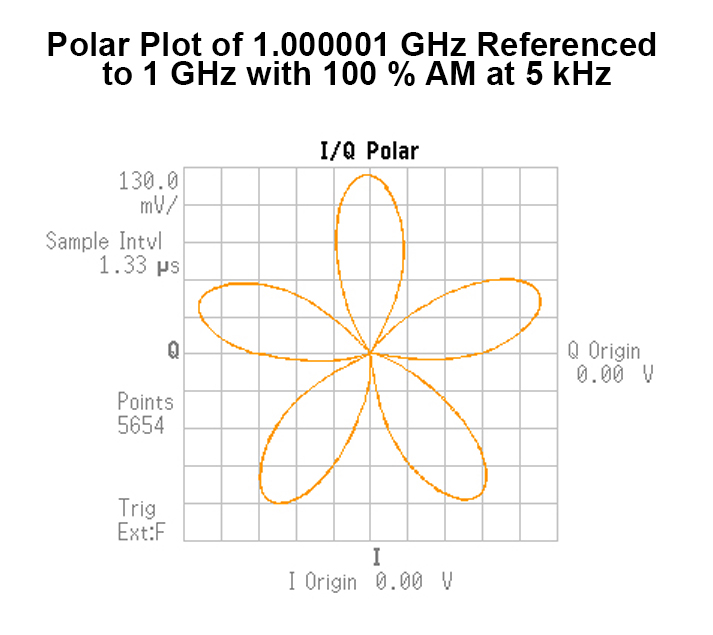
Polar Plot 1 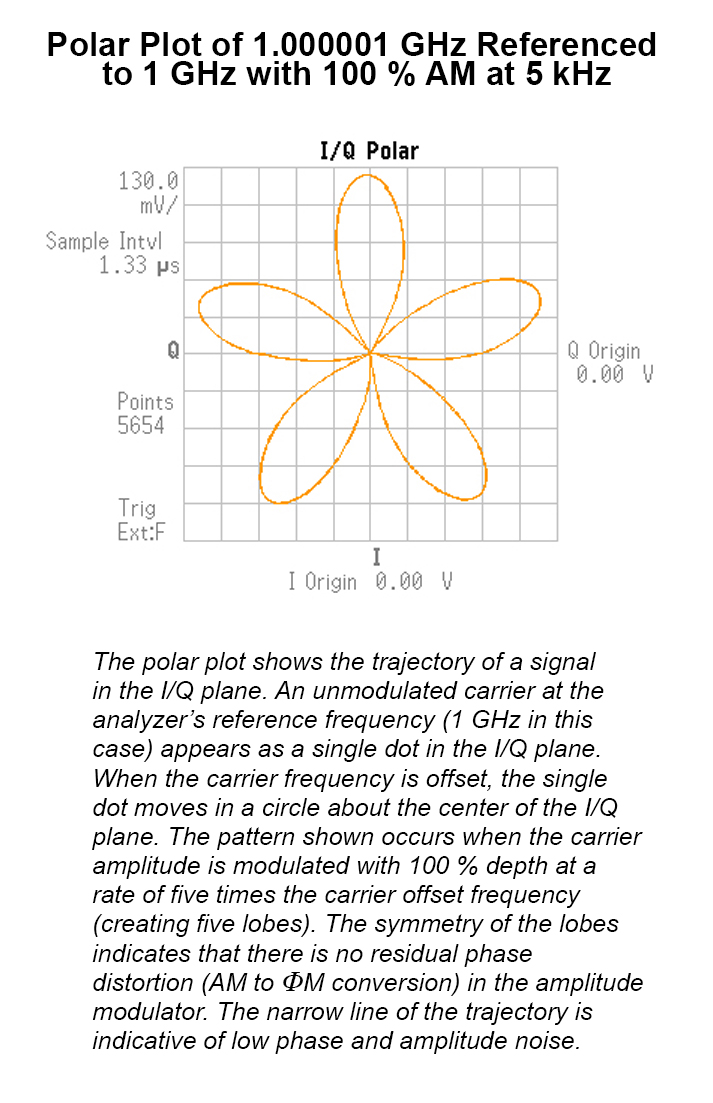
|
The SG380 Series Signal Generators are based on a new frequency synthesis technique called Rational Approximation Frequency Synthesis (RAFS). RAFS uses small integer divisors in a conventional phase-locked loop (PLL) to synthesize a frequency that would be close to the desired frequency (typically within ±100 ppm) using the nominal PLL reference frequency. The PLL reference frequency, which is sourced by a voltage control crystal oscillator that is phase locked to a dithered direct digital synthesizer, is adjusted so that the PLL generates the exact frequency. Doing so provides a high phase comparison frequency (typically 25 MHz) yielding low phase noise while moving the PLL reference spurs far from the carrier where they can be easily removed. The end result is an agile RF source with low phase noise, essentially infinite frequency resolution, without the spurs of

SG380 Series Specifications |
|
Frequency Setting |
|
| Frequency ranges | DC to 62.5 MHz (BNC output, all models) |
| SG382 | 950 kHz to 2.025 GHz (N-type output) |
| SG384 | 950 kHz to 4.05 GHz (N-type output) |
| SG386 | 950 kHz to 6.075 GHz (N-type output) |
| Frequency stability | <1×10-11 (1 s Allan variance) |
| Frequency resolution | 1 µHz at any frequency |
| Switching speed | <8 ms (to within 1 ppm) |
| Frequency error | <(10–18 + timebase error) × fC |
Front-Panel BNC Output |
|
| Frequency range | DC to 62.5 MHz |
| Amplitude | 1.00 to 0.001 Vrms |
| Offset | ±1.5 VDC |
| Offset resolution | 5 mV |
| Max. excursion | 1.817 V (amplitude + offset) |
| Amplitude resolution | <1 % |
| Amplitude accuracy | ±5 % |
| Harmonics | <-40 dBc |
| Spurious | <-75 dBc |
| Output coupling | DC, 50 Ω ±2 % |
| User load | 50 Ω |
| Reverse protection | ±5 VDC |
Front-Panel N-Type Output |
|
| Frequency range | |
| SG382 | 950 kHz to 2.025 GHz |
| SG384 | 950 kHz to 4.05 GHz |
| SG386 | 950 kHz to 6.075 GHz |
| Power output | |
| SG382 | +16.5 dBm to -110 dBm |
| SG384 | +16.5 dBm to -110 dBm (<3 GHz) |
| SG386 | +16.5 dBm to -110 dBm (<4 GHz) |
| Voltage output | |
| SG382 | 1.5 Vrms to 0.7 µVrms |
| SG384 | 1.5 Vrms to 0.7 µVrms (<3 GHz) |
| SG386 | 1.5 Vrms to 0.7 µVrms (<4 GHz) |
| Power resolution | 0.01 dBm |
| Power accuracy | ±1 dB (±2 dB above 4 GHz and above +5 dBm or below |
| Output coupling | AC, 50 Ω |
| User load | 50 Ω |
| VSWR | <1.6 |
| Reverse protection | 30 VDC, +25 dBm RF |
Spectral Purity of RF Out (referenced to 1 GHz*) |
|
| Sub harmonics | None (no doubler used below 4 GHz) |
| Harmonics | <-25 dBc (<+7 dBm on N-type output) |
| Spurious | <-65 dBc (offset <10 kHz) |
| <-75 dBc (offset: 10 kHz to 12 MHz) | |
| Phase noise (typ.) | |
| 10 Hz offset | -80 dBc/Hz |
| 1 kHz offset | -102 dBc/Hz |
| 20 kHz offset | -116 dBc/Hz (SG382 & SG384), -114 dBc/Hz (SG386) |
| 1 MHz offset | -130 dBc/Hz (SG382 & SG384), -124 dBc/Hz (SG386) |
| Residual FM (typ.) | 1 Hz rms (300 Hz to 3 kHz bandwidth) |
| Residual AM (typ.) | 0.006 % rms (300 Hz to 3 kHz bandwidth) |
| *Spurs, phase noise and residual FM scale by |
|
Phase Setting on Front-Panel Outputs |
|
| Max. phase step | ±360° |
| Phase resolution | 0.01° (DC to 100 MHz) 0.1° (100 MHz to 1 GHz) 1.0° (1 GHz to 6.075 GHz) |
Standard OCXO Timebase |
|
| Oscillator type | Oven controlled, 3rd OT, SC-cut crystal |
| Stability (0 to 45° C) | <±0.002 ppm |
| Aging | <±0.05 ppm/year |
Rubidium Timebase (opt. 04) |
|
| Oscillator type | Oven controlled, 3rd OT, SC-cut crystal |
| Physics package | Rubidium vapor frequency discriminator |
| Stability (0 to 45° C) | <±0.0001 ppm |
| Aging | <±0.001 ppm/year |
Timebase Input |
|
| Frequency | 10 MHz, ±2 ppm |
| Amplitude | 0.5 to 4 Vpp (-2 dBm to +16 dBm) |
| Input impedance | 50 Ω, AC coupled |
Timebase Output |
|
| Frequency | 10 MHz, sine |
| Source | 50 Ω, DC transformer coupled |
| Amplitude | 1.75 Vpp ±10 % (8.8 ± 1 dBm) |
Output Power Error |
|
| SG382 power error | -30 dBm to +10 dBm, DC to 2 GHz |
| SG384 power error | -30 dBm to +10 dBm, DC to 4 GHz |
| SG386 power error | -30 dBm to +10 dBm, DC to 6 GHz |
Internal Modulation Source |
|
| Waveforms | Sine, ramp, saw, square, pulse, noise |
| Sine THD | -80 dBc (typical at 20 kHz) |
| Ramp linearity | <0.05 % (1 kHz) |
| Rate | 1 µHz to 500 k Hz (fc ≤ 62.5 MHz (SG382 & SG384), fc ≤ 93.75 MHz (SG386)) 1 µHz to 50 k Hz (fc > 62.5 MHz (SG382 & SG384), fc > 93.75 MHz (SG386)) |
| Rate resolution | 1 µHz |
| Rate error | <1:231 + timebase error |
| Noise function | White Gaussian noise (rms = dev/5) |
| Noise bandwidth | 1 µHz < ENBW < 50 kHz |
| Pulse generator period | 1 µs to 10 s |
| Pulse generator width | 100 ns to 9999.9999 ms |
| Pulse timing resolution | 5 ns |
| Pulse noise function | PRBS 25 - 219. Bit period (100 + 5N) ns |
Modulation Waveform Output |
|
| Output impedance | 50 Ω (for reverse termination) |
| User load | Unterminated 50 Ω coax |
| AM, FM, ØM | ±1 V for ± full deviation |
| Pulse/Blank | "Low" = 0 V, "High" = 3.3 VDC |
External Modulation Input |
|
| Modes | AM, FM, ØM, Pulse, Blank |
| Unmodulated level | 0 V input for unmodulated carrier |
| AM, FM, ØM | ±1 V input for ± full deviation |
| Modulation bandwidth | >100 kHz |
| Modulation distortion | <-60 dB |
| Input impedance | 100 kΩ |
| Input offset | <500 µV |
| Pulse/Blank threshold | +1 VDC |
Amplitude Modulation |
|
| Range | 0 to 100 % (decreases above +7 dBm output) |
| Resolution | 0.1 % |
| Modulation source | Internal or external |
| Modulation distortion | <1 % (fc < 62.5 MHz, fm = 1 kHz, BNC output) <3 % (fc > 62.5 MHz, fm = 1 kHz, N-type output) |
| Modulation bandwidth | >100 kHz |
Phase Modulation |
|
| Deviation | 0 to 360° |
| Deviation resolution | 0.01° to 100 MHz, 0.1° to 1 GHz, 1° above 1 GHz |
| Deviation accuracy | <0.1 % (fc ≤ 62.5 MHz (SG382 & SG384), fc ≤ 93.75 MHz (SG386)) <3 % (fc > 62.5 MHz (SG382 & SG384), fc > 93.75 MHz (SG386)) |
| Modulation source | Internal or external |
| Modulation distortion | <-60 dB (fc = 100 MHz, fM =1 kHz, ØD =50°) |
| Modulation bandwidth | 500 kHz (fc ≤ 62.5 MHz (SG382 & SG384), fc ≤ 93.75 MHz (SG386)) 100 kHz (fc > 62.5 MHz (SG382 & SG384), fc > 93.75 MHz (SG386)) |
Frequency Modulation |
|
| Min. freq. deviation | 0.1 Hz |
| Max. freq. deviation | SG382 & SG384 |
| Smaller of fc or (64 MHz - fc),(fc < 62.5 MHz) | |
| 1 MHz, (62.5 MHz < fc ≤ 126.5625 MHz) | |
| 2 MHz, (126.5625 MHz < fc ≤ 253.1250) | |
| 4 MHz, (253.1250 MHz < fc ≤ 506.25 MHz) | |
| 8 MHz, (506.25 MHz < fc ≤ 1.0125 GHz) | |
| 16 MHz, (1.0125 GHz < fc ≤ 2.025 GHz) | |
| 32 MHz, (2.025 GHz < fc ≤ 4.050 GHz (SG384)) | |
| SG386 | |
| Smaller of fc or (96 MHz - fc), (fc < 93.75 MHz) | |
| 1 MHz, (93.75 MHz < fc ≤ 189.84375 MHz) | |
| 2 MHz, (189.84375 MHz < fc ≤ 379.6875 MHz) | |
| 4 MHz, (379.6875 MHz < fc ≤ 759.375 MHz | |
| 8 MHz, (759.375 MHz < fc ≤ 1.51875 GHz) | |
| 16 MHz, (1.51875 GHz < fc ≤ 3.0375 GHz) | |
| 32 MHz, (3.0375 GHz < fc ≤ 6.075 GHz (SG384)) | |
| Deviation resolution | 0.1 Hz |
| Deviation accuracy | <0.1 % (fc ≤ 62.5 MHz (SG382 & SG384), fc ≤ 93.75 MHz (SG386)) <3 % (fc > 62.5 MHz (SG382 & SG384), fc > 93.75 MHz (SG386)) |
| Modulation source | Internal or external |
| Modulation distortion | <-60 dB (fc = 100 MHz, fM = 1 kHz, fD = 1 kHz) |
| Ext FM carrier offset | <1:1,000 of deviation |
| Modulation bandwidth | 500 kHz (fc ≤ 62.5 MHz (SG382 & SG384), fc ≤ 93.75 MHz (SG386)) |
| 100 kHz (fc > 62.5 MHz (SG382 & SG384), fc > 93.75 MHz (SG386)) |
|
Frequency Sweeps (phase continuous) |
|
| Frequency span | 10 Hz to entire sweep range |
| Sweep ranges | SG382 & SG384 DC to 64 MHz 59.375 to 128.125 MHz 118.75 to 256.25 MHz 237.5 to 512.5 MHz 475 to 1025 MHz 950 to 2050 MHz 1900 to 4100 MHz (SG384) SG386 DC to 96 MHz 89.0625 MHz to 192.188 MHz 178.125 MHz to 384.375 MHz 356.25 MHz to 768.75 MHz 712.5 MHz to 1537.5 MHz 1425 MHz to 3075 MHz 2850 MHz to 6150 MHz |
| Deviation resolution | 0.1 Hz |
| Sweep source | Internal or external |
| Sweep distortion | <0.1 Hz + deviation/1,000 |
| Sweep offset | <1:1,000 of deviation |
| Sweep function | Triangle, ramp or sine sweeps up to 120 Hz |
Pulse/Blank Modulation |
|
| Pulse mode | Logic "high" turns RF "on" |
| Blank mode | Logic "high" turns RF "off" |
| On/Off ratio | |
| BNC output | 70 dB |
| Type-N output | 57 dB (fc < 1 GHz) 40 dB (1 GHz ≤ fc< 4 GHz) 35 dB (fc ≥ 4 GHz) |
| Pulse feed-through | 10 % of carrier for 20 ns at turn-on (typ.) |
| Turn on/off delay | 60 ns |
| RF rise/fall time | 20 ns |
| Modulation source | Internal or external pulse |
External I/Q Modulation (opt. 03) |
|
| Carrier frequency range | 400 MHz to 2.025 GHz (SG382) 400 MHz to 4.05 GHz (SG384) 400 MHz to 6.075 GHz (SG386) |
| Modulated output | Front-panel N-type only |
| I/Q inputs | 50 Ω, ±0.5 V |
| I or Q input offset | <500 µV |
| I/Q full scale | (I2 + Q2)1/2 = 0.5 V |
| Carrier suppression | >40 dBc (up to 4 GHz) |
| Modulation bandwidth | 200 MHz (-3 dB) |
Square Wave Clock Outputs (opt. 01) |
|
| Differential clocks | Rear-panel SMAs drive 50 Ω loads |
| Frequency range | DC to 4.05 GHz |
| Transition time | <35 ps (20 % to 80 %) |
| Jitter | |
| (fc > 62.5 MHz) | 300 fs rms (typical, 1 kHz to 5 MHz BW at 1 GHz) |
| (fc ≤ 62.5 MHz) | <10-4 U.I. (1 kHz to 5 MHz or fc/2 BW) |
| Amplitude | 0.4 to 1 Vpp |
| Offset | ±2 VDC |
| Ampl & Offs resolution | 5 mV |
| Ampl & Offs accuracy | ±5 % |
| Output coupling | DC, 50 Ω ±2 % |
| Compliance | ECL, PECL, RSECL, CML, NIM & LVDS |
Frequency Doubler Output (opt. 02) |
|
| Output | Rear-panel SMA |
| Frequency range | 4.05 GHz to 8.10 GHz (SG384) 6.075 GHz to 8.10 GHz (SG386) |
| RF amplitude | -10 dBm to +13 dBm (4.05 GHz to 7 GHz) -10 dBm to +7 dBm (7 GHz to 8.10 GHz) +13 to +16.5 dBm (spec. not guaranteed) |
| Sub harmonic (fc/2) | <-25 dBc (fC < 6.5 GHz) <-12 dBc (fC < 8.1 GHz) |
| Mixing products (3fc/2) | <-20 dBc |
| Harmonics (n x fc) | <-25 dBc |
| Spurious (8 GHz) | <-55 dBc (>10 kHz offset) |
| Phase noise (8 GHz) | -98 dBc/Hz at 20 kHz offset (typ.) |
| Amplitude resolution | 0.01 dBm |
| Amplitude accuracy | ±1 dB (4.05 GHz to 6.5 GHz) ±2 dB (6.5 GHz to 8.1 GHz) |
| Modulation modes | FM, ØM, Sweeps |
| Output coupling | AC, 50 Ω |
| Reverse protection | 30 VDC, +25 dBm RF |
DC Bias Source (comes with opt. 02) |
|
| Output | Rear-panel SMA |
| Voltage range | ±10 V |
| Offset voltage | <20 mV |
| DC accuracy | ±0.2 % |
| DC resolution | 5 mV |
| Output resistance | 50 Ω |
| Current limit | 20 mA |
Computer Interfaces |
|
| Ethernet (LAN) | 10/100 Base-T. TCP/IP & DHCP default |
| GPIB | IEEE-488.2 |
| RS-232 | 4800 to 115,200 baud, RTS/CTS flow line |
General |
|
| Line power | <90 W, 90 to 264 VAC, 47 to 63 Hz with PFC |
| Dimensions | 8.5" × 3.5" × 13" (WHL) |
| Weight | 10 lbs. |
| Warranty | One year parts and labor on defects in materials & workmanship |
SG380 Specifications |
|
Frequency Setting |
|
| Frequency ranges | DC to 62.5 MHz (BNC output, all models) |
| SG382 | 950 kHz to 2.025 GHz (N-type output) |
| SG384 | 950 kHz to 4.05 GHz (N-type output) |
| SG386 | 950 kHz to 6.075 GHz (N-type output) |
| Frequency stability | <1×10-11 (1 s Allan variance) |
| Frequency resolution | 1 µHz at any frequency |
| Switching speed | <8 ms (to within 1 ppm) |
| Frequency error | <(10–18 + timebase error) × fC |
Front-Panel BNC Output |
|
| Frequency range | DC to 62.5 MHz |
| Amplitude | 1.00 to 0.001 Vrms |
| Offset | ±1.5 VDC |
| Offset resolution | 5 mV |
| Max. excursion | 1.817 V (amplitude + offset) |
| Amplitude resolution | <1 % |
| Amplitude accuracy | ±5 % |
| Harmonics | <-40 dBc |
| Spurious | <-75 dBc |
| Output coupling | DC, 50 Ω ±2 % |
| User load | 50 Ω |
| Reverse protection | ±5 VDC |
Front-Panel N-Type Output |
|
| Frequency range | |
| SG382 | 950 kHz to 2.025 GHz |
| SG384 | 950 kHz to 4.05 GHz |
| SG386 | 950 kHz to 6.075 GHz |
| Power output | |
| SG382 | +16.5 dBm to -110 dBm |
| SG384 | +16.5 dBm to -110 dBm (<3 GHz) |
| SG386 | +16.5 dBm to -110 dBm (<4 GHz) |
| Voltage output | |
| SG382 | 1.5 Vrms to 0.7 µVrms |
| SG384 | 1.5 Vrms to 0.7 µVrms (<3 GHz) |
| SG386 | 1.5 Vrms to 0.7 µVrms (<4 GHz) |
| Power resolution | 0.01 dBm |
| Power accuracy | ±1 dB (±2 dB above 4 GHz and above +5 dBm or below -100 dBm) |
| Output coupling | AC, 50 Ω |
| User load | 50 Ω |
| VSWR | <1.6 |
| Reverse protection | 30 VDC, +25 dBm RF |
Spectral Purity (RF Out ref. to 1 GHz*) |
|
| Sub harmonics | None (no doubler used below 4 GHz) |
| Harmonics | <-25 dBc (<+7 dBm on N-type output) |
| Spurious | <-65 dBc (offset <10 kHz) |
| <-75 dBc (offset: 10 kHz to 12 MHz) | |
| Phase noise (typ.) | |
| 10 Hz offset | -80 dBc/Hz |
| 1 kHz offset | -102 dBc/Hz |
| 20 kHz offset | -116 dBc/Hz (SG382 & SG384), -114 dBc/Hz (SG386) |
| 1 MHz offset | -130 dBc/Hz (SG382 & SG384), -124 dBc/Hz (SG386) |
| Residual FM (typ.) | 1 Hz rms (300 Hz to 3 kHz bandwidth) |
| Residual AM (typ.) | 0.006 % rms (300 Hz to 3 kHz bandwidth) |
| *Spurs, phase noise and residual FM scale by |
|
Phase Setting (Front-Panel Outputs) |
|
| Max. phase step | ±360° |
| Phase resolution | 0.01° (DC to 100 MHz) 0.1° (100 MHz to 1 GHz) 1.0° (1 GHz to 6.075 GHz) |
Standard OCXO Timebase |
|
| Oscillator type | Oven controlled, 3rd OT, |
| Stability (0 to 45° C) | <±0.002 ppm |
| Aging | <±0.05 ppm/year |
Rubidium Timebase (opt. 04) |
|
| Oscillator type | Oven controlled, 3rd OT, |
| Physics package | Rubidium vapor frequency discriminator |
| Stability (0 to 45° C) | <±0.0001 ppm |
| Aging | <±0.001 ppm/year |
Timebase Input |
|
| Frequency | 10 MHz, ±2 ppm |
| Amplitude | 0.5 to 4 Vpp (-2 dBm to +16 dBm) |
| Input impedance | 50 Ω, AC coupled |
Timebase Output |
|
| Frequency | 10 MHz, sine |
| Source | 50 Ω, DC transformer coupled |
| Amplitude | 1.75 Vpp ±10 % (8.8 ± 1 dBm) |
Output Power Error |
|
| SG382 power error | -30 dBm to +10 dBm (DC to 2 GHz) |
| SG384 power error | -30 dBm to +10 dBm (DC to 4 GHz) |
| SG386 power error | -30 dBm to +10 dBm (DC to 6 GHz) |
Internal Modulation Source |
|
| Waveforms | Sine, ramp, saw, square, pulse, noise |
| Sine THD | -80 dBc (typical at 20 kHz) |
| Ramp linearity | <0.05 % (1 kHz) |
| Rate | 1 µHz to 500 k Hz (fc ≤ 62.5 MHz (SG382 & SG384), fc ≤ 93.75 MHz (SG386)) 1 µHz to 50 k Hz (fc > 62.5 MHz (SG382 & SG384), fc > 93.75 MHz (SG386)) |
| Rate resolution | 1 µHz |
| Rate error | <1:231 + timebase error |
| Noise function | White Gaussian noise (rms = dev/5) |
| Noise bandwidth | 1 µHz < ENBW < 50 kHz |
| Pulse generator period | 1 µs to 10 s |
| Pulse generator width | 100 ns to 9999.9999 ms |
| Pulse timing resolution | 5 ns |
| Pulse noise function | PRBS 25 - 219. Bit period (100 + 5N) ns |
Modulation Waveform Output |
|
| Output impedance | 50 Ω (for reverse termination) |
| User load | Unterminated 50 Ω coax |
| AM, FM, ØM | ±1 V for ± full deviation |
| Pulse/Blank | "Low" = 0 V, "High" = 3.3 VDC |
External Modulation Input |
|
| Modes | AM, FM, ØM, Pulse, Blank |
| Unmodulated level | 0 V input for unmodulated carrier |
| AM, FM, ØM | ±1 V input for ± full deviation |
| Modulation bandwidth | >100 kHz |
| Modulation distortion | <-60 dB |
| Input impedance | 100 kΩ |
| Input offset | <500 µV |
| Pulse/Blank threshold | +1 VDC |
Amplitude Modulation |
|
| Range | 0 to 100 % (decreases above +7 dBm output) |
| Resolution | 0.1 % |
| Modulation source | Internal or external |
| Modulation distortion | <1 % (fc < 62.5 MHz, fm = 1 kHz, BNC output) <3 % (fc > 62.5 MHz, fm = 1 kHz, |
| Modulation bandwidth | >100 kHz |
Frequency Modulation |
|
| Min. freq. deviation | 0.1 Hz |
| Max. freq. deviation | SG382 & SG384 |
| Smaller of fc or (64 MHz - fc), (fc < 62.5 MHz) |
|
| 1 MHz, (62.5 MHz < fc ≤ 126.5625 MHz) |
|
| 2 MHz, (126.5625 MHz < fc ≤ 253.1250 MHz) |
|
| 4 MHz, (253.1250 MHz < fc ≤ 506.25 MHz) |
|
| 8 MHz, (506.25 MHz < fc ≤ 1.0125 GHz) |
|
| 16 MHz, (1.0125 GHz < fc ≤ 2.025 GHz) |
|
| 32 MHz, (2.025 GHz < fc ≤ 4.050 GHz (SG384)) |
|
| SG386 | |
| Smaller of fc or (96 MHz - fc), (fc < 93.75 MHz) |
|
| 1 MHz, (93.75 MHz < fc ≤ 189.84375 MHz) |
|
| 2 MHz, (189.84375 MHz < fc ≤ 379.6875 MHz) |
|
| 4 MHz, (379.6875 MHz < fc ≤ 759.375 MHz) |
|
| 8 MHz, (759.375 MHz < fc ≤ 1.51875 GHz) |
|
| 16 MHz, (1.51875 GHz < fc ≤ 3.0375 GHz) |
|
| 32 MHz, (3.0375 GHz < fc ≤ 6.075 GHz (SG384)) |
|
| Deviation resolution | 0.1 Hz |
| Deviation accuracy | <0.1 % (fc ≤ 62.5 MHz (SG382 & SG384), fc ≤ 93.75 MHz (SG386)) <3 % (fc > 62.5 MHz (SG382 & SG384), fc > 93.75 MHz (SG386)) |
| Modulation source | Internal or external |
| Modulation distortion | <-60 dB (fc = 100 MHz, fM = 1 kHz, fD = 1 kHz) |
| Ext FM carrier offset | <1:1,000 of deviation |
| Modulation bandwidth | 500 kHz (fc ≤ 62.5 MHz (SG382 & SG384), fc ≤ 93.75 MHz (SG386)) |
| 100 kHz (fc > 62.5 MHz (SG382 & SG384), fc > 93.75 MHz (SG386)) |
|
Frequency Sweeps |
|
| Frequency span | 10 Hz to entire sweep range |
| Sweep ranges | SG382 & SG384 DC to 64 MHz 59.375 to 128.125 MHz 118.75 to 256.25 MHz 237.5 to 512.5 MHz 475 to 1025 MHz 950 to 2050 MHz 1900 to 4100 MHz (SG384) SG386 DC to 96 MHz 89.0625 MHz to 192.188 MHz 178.125 MHz to 384.375 MHz 356.25 MHz to 768.75 MHz 712.5 MHz to 1537.5 MHz 1425 MHz to 3075 MHz 2850 MHz to 6150 MHz |
| Deviation resolution | 0.1 Hz |
| Sweep source | Internal or external |
| Sweep distortion | <0.1 Hz + deviation/1,000 |
| Sweep offset | <1:1,000 of deviation |
| Sweep function | Triangle, ramp or sine sweeps up to 120 Hz |
Phase Modulation |
|
| Deviation | 0 to 360° |
| Deviation resolution | 0.01° to 100 MHz, 0.1° to 1 GHz, |
| Deviation accuracy | <0.1 % (fc ≤ 62.5 MHz (SG382 & SG384), fc ≤ 93.75 MHz (SG386)) <3 % (fc > 62.5 MHz (SG382 & SG384), fc > 93.75 MHz (SG386)) |
| Modulation source | Internal or external |
| Modulation distortion | <-60 dB (fc = 100 MHz, fM =1 kHz, ØD =50°) |
| Modulation bandwidth | 500 kHz (fc ≤ 62.5 MHz (SG382 & SG384), fc ≤ 93.75 MHz (SG386)) 100 kHz (fc > 62.5 MHz (SG382 & SG384), fc > 93.75 MHz (SG386)) |
Pulse/Blank Modulation |
|
| Pulse mode | Logic "high" turns RF "on" |
| Blank mode | Logic "high" turns RF "off" |
| On/Off ratio | |
| BNC output | 70 dB |
| Type-N output | 57 dB (fc < 1 GHz) 40 dB (1 GHz ≤ fc< 4 GHz) 35 dB (fc ≥ 4 GHz) |
| Pulse feed-through | 10 % of carrier for 20 ns at turn-on (typ.) |
| Turn on/off delay | 60 ns |
| RF rise/fall time | 20 ns |
| Modulation source | Internal or external pulse |
External I/Q Modulation (opt. 03) |
|
| Carrier freq. range | 400 MHz to 2.025 GHz (SG382) 400 MHz to 4.05 GHz (SG384) 400 MHz to 6.075 GHz (SG386) |
| Modulated output | Front-panel N-type only |
| I/Q inputs | 50 Ω, ±0.5 V |
| I or Q input offset | <500 µV |
| I/Q full scale | (I2 + Q2)1/2 = 0.5 V |
| Carrier suppression | >40 dBc (up to 4 GHz) |
| Modulation bandwidth | 200 MHz (-3 dB) |
Square Wave Clock Outputs (opt. 01) |
|
| Differential clocks | Rear-panel SMAs drive 50 Ω loads |
| Frequency range | DC to 4.05 GHz |
| Transition time | <35 ps (20 % to 80 %) |
| Jitter | |
| (fc > 62.5 MHz) | 300 fs rms (typ., 1 kHz to 5 MHz BW at 1 GHz) |
| (fc ≤ 62.5 MHz) | <10-4 U.I. (1 kHz to 5 MHz or fc/2 BW) |
| Amplitude | 0.4 to 1 Vpp |
| Offset | ±2 VDC |
| Ampl & Offs resolution | 5 mV |
| Ampl & Offs accuracy | ±5 % |
| Output coupling | DC, 50 Ω ±2 % |
| Compliance | ECL, PECL, RSECL, CML, NIM & LVDS |
Frequency Doubler Output (opt. 02) |
|
| Output | Rear-panel SMA |
| Frequency range | 4.05 GHz to 8.10 GHz (SG384) 6.075 GHz to 8.10 GHz (SG386) |
| RF amplitude | -10 dBm to +13 dBm (4.05 GHz to 7 GHz) -10 dBm to +7 dBm (7 GHz to 8.10 GHz) +13 to +16.5 dBm (spec. not guaranteed) |
| Sub harmonic (fc/2) | <-25 dBc (fC < 6.5 GHz) <-12 dBc (fC < 8.1 GHz) |
| Mixing products (3fc/2) | <-20 dBc |
| Harmonics (n x fc) | <-25 dBc |
| Spurious (8 GHz) | <-55 dBc (>10 kHz offset) |
| Phase noise (8 GHz) | -98 dBc/Hz at 20 kHz offset (typ.) |
| Amplitude resolution | 0.01 dBm |
| Amplitude accuracy | ±1 dB (4.05 GHz to 6.5 GHz) ±2 dB (6.5 GHz to 8.1 GHz) |
| Modulation modes | FM, ØM, Sweeps |
| Output coupling | AC, 50 Ω |
| Reverse protection | 30 VDC, +25 dBm RF |
DC Bias Source (comes with opt. 02) |
|
| Output | Rear-panel SMA |
| Voltage range | ±10 V |
| Offset voltage | <20 mV |
| DC accuracy | ±0.2 % |
| DC resolution | 5 mV |
| Output resistance | 50 Ω |
| Current limit | 20 mA |
Computer Interfaces |
|
| Ethernet (LAN) | 10/100 Base-T. TCP/IP & DHCP default |
| GPIB | IEEE-488.2 |
| RS-232 | 4800 to 115,200 baud, RTS/CTS flow line |
| General | |
| Line power | <90 W, 90 to 264 VAC, 47 to 63 Hz with PFC |
| Dimensions | 8.5" × 3.5" × 13" (WHL) |
| Weight | 10 lbs. |
| Warranty | One year parts and labor on defects in materials & workmanship |
